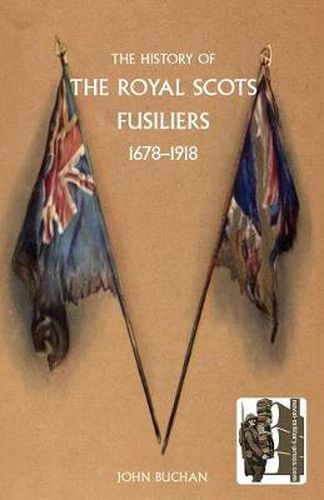Readings Newsletter
Become a Readings Member to make your shopping experience even easier.
Sign in or sign up for free!
You’re not far away from qualifying for FREE standard shipping within Australia
You’ve qualified for FREE standard shipping within Australia
The cart is loading…






This title is printed to order. This book may have been self-published. If so, we cannot guarantee the quality of the content. In the main most books will have gone through the editing process however some may not. We therefore suggest that you be aware of this before ordering this book. If in doubt check either the author or publisher’s details as we are unable to accept any returns unless they are faulty. Please contact us if you have any questions.
For the first ten years of its existence the regiment was on the Scottish establishment, but with the abdication of James II and the arrival of William (and Mary) the RSF came over to the English establishment as a Fusilier regiment (it had been equipped with ‘fusils’ instead of matchlocks), first known as The Scots Fusiliers Regiment of Foot, changed around 1713 to The Royal North British Fusiliers and when, in 1751, the regiments of the line were numbered it became the 21st (Royal North British) Fusiliers Regiment of Foot. This was its title till 1877 when it became the 21st (Royal Scots Fusiliers) Regiment of Foot, and finally, in 1881, The Royal Scots Fusiliers. Most regimental histories cover the 1914-18 War in one or more separate volumes, but here that conflict takes up the final third or so of the book in which Buchan devotes one chapter to each year of the war and, at the end of the chapter, lists in alphabetical order the names of the officers who died in that year, with date but not place (theatre) of death. As there were nine battalions (1, 2, ¼, 1/5, 6, 7, 8, 11 and 12) which between them served on the Western Front, in Gallipoli, Egypt, Palestine and Macedonia, this doesn’t leave too much room for detail. But this lack is redressed by some fine, descriptive writing which provides the reader with a clear picture of the regiment’s part in that war. Four VCs were won and the dead numbered 5,600. It is the same with the pre-1914 history which makes for easy and absorbing reading. In its early days the regiment fought against the Jacobite uprisings of 1715 and 1745, and was in the centre of Cumberland’s first line at Culloden which put an end to the Highland rebellion. In the American War of Independence the regiment was part of Burgoyne’s force compelled to surrender at Saratoga. In 1814 the regiment led the way in the capture of Washington. It fought at the Alma and Inkerman in the Crimea, at Ulundi in the Zulu War and in the S African War won its first VC at Colenso. In an appendix all the Colonels of the regiment are listed and the COs of all the battalions.
$9.00 standard shipping within Australia
FREE standard shipping within Australia for orders over $100.00
Express & International shipping calculated at checkout
This title is printed to order. This book may have been self-published. If so, we cannot guarantee the quality of the content. In the main most books will have gone through the editing process however some may not. We therefore suggest that you be aware of this before ordering this book. If in doubt check either the author or publisher’s details as we are unable to accept any returns unless they are faulty. Please contact us if you have any questions.
For the first ten years of its existence the regiment was on the Scottish establishment, but with the abdication of James II and the arrival of William (and Mary) the RSF came over to the English establishment as a Fusilier regiment (it had been equipped with ‘fusils’ instead of matchlocks), first known as The Scots Fusiliers Regiment of Foot, changed around 1713 to The Royal North British Fusiliers and when, in 1751, the regiments of the line were numbered it became the 21st (Royal North British) Fusiliers Regiment of Foot. This was its title till 1877 when it became the 21st (Royal Scots Fusiliers) Regiment of Foot, and finally, in 1881, The Royal Scots Fusiliers. Most regimental histories cover the 1914-18 War in one or more separate volumes, but here that conflict takes up the final third or so of the book in which Buchan devotes one chapter to each year of the war and, at the end of the chapter, lists in alphabetical order the names of the officers who died in that year, with date but not place (theatre) of death. As there were nine battalions (1, 2, ¼, 1/5, 6, 7, 8, 11 and 12) which between them served on the Western Front, in Gallipoli, Egypt, Palestine and Macedonia, this doesn’t leave too much room for detail. But this lack is redressed by some fine, descriptive writing which provides the reader with a clear picture of the regiment’s part in that war. Four VCs were won and the dead numbered 5,600. It is the same with the pre-1914 history which makes for easy and absorbing reading. In its early days the regiment fought against the Jacobite uprisings of 1715 and 1745, and was in the centre of Cumberland’s first line at Culloden which put an end to the Highland rebellion. In the American War of Independence the regiment was part of Burgoyne’s force compelled to surrender at Saratoga. In 1814 the regiment led the way in the capture of Washington. It fought at the Alma and Inkerman in the Crimea, at Ulundi in the Zulu War and in the S African War won its first VC at Colenso. In an appendix all the Colonels of the regiment are listed and the COs of all the battalions.